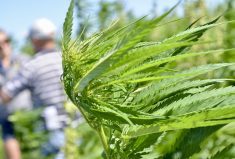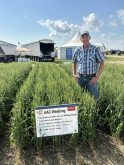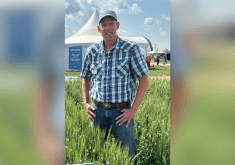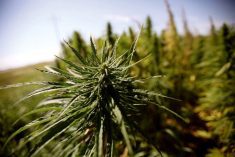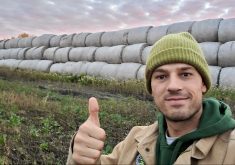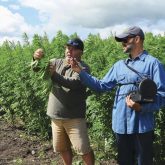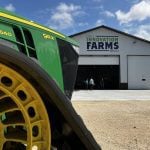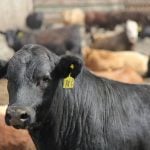Hemp has had its ups and downs on the Prairies.
Jeff Kostuik of Verve Seeds would like to see it get a better foothold, and he thinks new genetics, better tailored for western Canadian conditions and western Canadian markets, can help make that happen.
“We’re a very small, yet mighty company … we probably have one of the largest breeding programs in the world right now in hemp genetics,” he said, speaking at a field day at the Westman Agricultural Diversification Organization near Melita, Man.
Read Also

Hail research hopes to benefit potato growers
Alberta research scientist measures hail storm and heat dome affects on potato crops
Hemp has the blessing and curse of versatility. On the Prairies, its biggest market is food-grade grain, but the industry has also flagged growth opportunity in markets like fibre and nutraceuticals.
Fibre processors have dug niches in animal bedding and absorbent materials, but innovation-oriented organizations have said its uses could extend to sustainable construction materials. High quality fibre could feed into textiles. Grain can be crushed, yielding an oil with good nutritional properties.
There was initially great excitement around CBD (cannabidiol oil), but it was later dampened by logistical challenges.
That wealth of potential end uses, and corresponding demand for different varietal traits, is split between relatively few growers. According to Statistics Canada, about 54,60o acres of hemp were harvested nationwide in 2023.
Targeting grain
The sheer size of hemp plants has made it a harvest headache in the past, particularly to grain growers, for whom the extra vegetation is just more residue to potentially tangle up in the combine.
“Fibre varieties tend to produce more fibre but less seed, so it’s another challenge for the seed company,” Kostuik said. “So the breeding efforts have been to shorten the crop, get it so that it’s more manageable.”
Verve Seeds developed hemp with more uniformity in crop size, which Kostuik counts as a major breakthroughs in their program.
“We’ve got the varieties at the height that we want and now we’re working on yield and making sure that we’re not missing anything on quality assessment.”
A botanical quirk posed yet another problem. Hemp is dioecious; each plant is either male or female. In fibre production, that’s not a problem. For seed or grain, however, the males are wasted production space, taking up room and providing no harvestable material. A field population with greater numbers of females is a more profitable field.
To address this, Verve developed the world’s first dioecious hybrid hemp.
“It’s called T3H2006, but it’s more suited for Kentucky than here,” Kostuik said.“The objective in the hybridity is reduced maleness and we’re probably down to less than 10 per cent of the plants are male as opposed to 50 per cent. If we have more females than males, there should be a yield bump on that right away.”
That sounds like a good deal, according to Clarence Shwaluk of Manitoba Harvest, a company that specializes in developing and marketing hemp food products.
“We’re in the food business so we’re not interested in the big, tall varieties. We’re just looking for the seed,” he said. “What we want to get from a field that’s contracted to us is a good high-yielding variety, one that processes well for us and one that’s good for the consumer.”
Manitoba Harvest has contracted 800 to 1,000 acres of one such hopeful variety, Rak, this year.
“It’s experimental for us, but we’re looking for a variety that works at every level of the value chain,” Shwaluk said.
In an interview with the Western Producer earlier this year, Alberta Hemp Alliance consultant Russ Crawford said he hoped hybrid genetics might significantly improve western Canadian hemp.
Two of the three biggest issues with the crop are rooted in genetics, he said at the time: yield and seed consistency.
It is the industry’s hope that average production could jump from 700-1,000 pounds per acre to 1,300-1,500 pounds per acre. That would give producers more to sell, and might decrease hemp’s cost as an ingredient, making it more attractive for food companies, the Western Producer reported.
Verve Seeds was one of the companies selected by the alliance for hybrid development.
Processing
Shwaluk says Manitoba Harvest processes hemp in two ways. The first is dehulling hemp hearts, the soft and chewy centre of the hemp seed. The result is similar to the inside of a sunflower seed, with a soft, nutty flavour. Those hearts are typically used in salads, sauces or sprinkled on cereal.
“If you’ve seen hemp hearts in the grocery stores, if it has a Manitoba Harvest label, it came from us. We also do some private label, President’s Choice, Costco and there’s a few others that we do as well,” he said.
Hemp hearts make up about 80 per cent of its processing. The rest is crushing, which yields an omega-3 oil that is popular in specialty food stores.
“In addition to that, we also make granola with hemp in it,” Shwaluk said. “We also make our own line of oatmeal with hemp. We have a snack line ready for launch and we’re just getting into the dietary fibre. We’re utilizing the shell that, up till now, (was) a waste product, so we’re looking for multiple uses for the crop and trying to build that market and keep that growing.”
Growing hemp
The food company also has its own line of agronomists tasked with coaching producers who want to grow what is, for many, a novel crop.
“As soon as they sign that contract with us, the agronomist is working to look at soil rotations, what sort of fertility do you need? What sort of crop has been in the field prior and what sort of diseases might you expect?” Shwaluk said.
Hemp is considered an oilseed, and fits fairly well in the rotation for most Prairie growers, said Kostuik. Wheat can do well the year after it. Hemp is susceptible to sclerotinia, but so are other oilseeds a farmer might grow in that slot.
“On the insect side of things, cutworms can be an issue, and that seems to be the biggest one,” he said, adding the European corn borer can be another challenge. — With files from Robert Arnason



